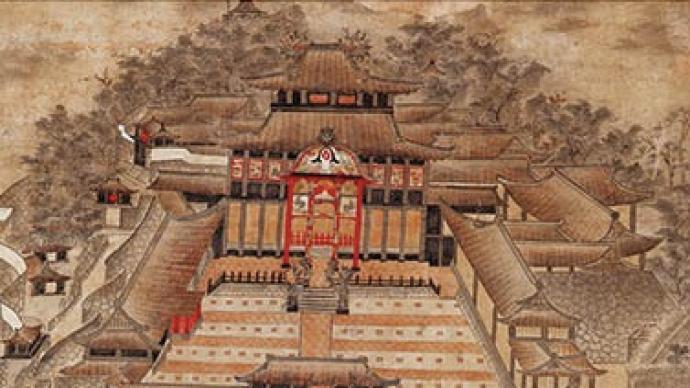
The Paper has learned that the Tokyo National Museum recently launched a special exhibition "Ryukyu", which focuses on the Ryukyu Kingdom established in the second half of the 15th century. Focus on the formation of its unique history and culture, and how to continue and inherit traditions after modernization. This also makes the Chinese people feel that the topic is heavy and their mood is complicated .
The Ryukyu Islands are located on the eastern periphery of the East China Sea, with a total length of more than 1,000 kilometers from north to south. Historically, the Ryukyu Islands have long been a vassal of China.
After the end of World War II, it was under the jurisdiction of Japan, a defeated country in World War II, but the administrative power in some areas was still exercised by the United States. The U.S. military later handed over the Ryukyu Islands to Japan as a trustee. Historically, due to a large number of immigrants from southern Fujian, China, its customs and habits are quite different from Japanese culture. In the Ming and Qing dynasties, Ryukyu has always been a vassal of China. Maintain close cultural exchanges and overseas trade with China, Japan, North Korea and Southeast Asian countries.
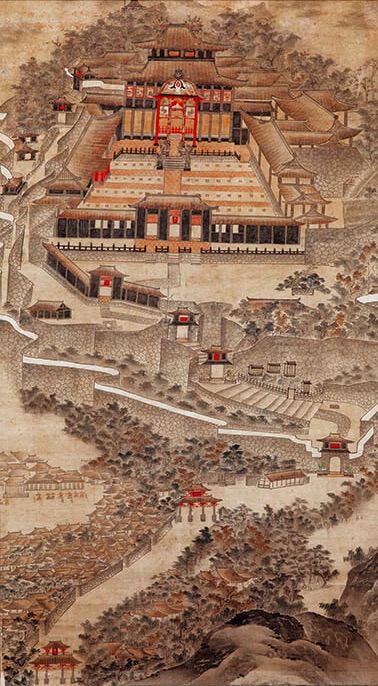
Shuri Castle Map, Second Shang Dynasty (19th century);
It depicts Shuri Castle in the first half of the 19th century, and it is a precious drawing that reflects the appearance of Shuri Castle during the kingdom era.

The plaque of the former Ryukyu Shuri Castle
In fact, until 1919, when Xu Shichang, then the President of the Republic of China, organized a collection of Qing poetry collections "Wan Qing Ji Poetry Collection" (compiled in 1929), he still regarded the poems of Ryukyu poets as "subject". The works are collected in the last volume.In 1925, the poet Wen Yiduo published "Song of Seven Sons", which included Macau, Hong Kong, Taiwan, Weihaiwei (now Weihai, Shandong), Guangzhou Bay (now Zhanjiang, Guangdong), Kowloon, and Lushun Dalian, which were occupied by foreign powers at that time. The seven places are likened to seven sons who have left their mother's arms.
In the "Taiwan Region" section he wrote about Ryukyu:
"We are a string of pearls held by the East China Sea,
Ryukyu is my younger brother, and I am Taiwan.
I still have the heroic soul of the Zheng family in my chest,
The red blood of the faithful has stained my family heritage. …”
The current Ryukyu (Okinawa) is administratively managed by Japan, speaking and writing in Japanese.

exhibition site
The Tokyo National Museum has a large number of Ryukyu cultural relics (including the collections purchased from Okinawa during the Meiji period in Japan and later donated). Showcasing the dazzling Ryukyu culture.The preparations for the exhibition lasted for five years, during which Okinawa Shuri Castle was burned down on October 31, 2019. Since then, the new crown pandemic has also prevented the work from proceeding as expected. Under the coordination of various staff, the exhibition was held as scheduled. The exhibition tells the history that is not discussed in depth in textbooks, but reveals the significance of the formation and inheritance of the Ryukyu Kingdom and its unique culture through the cultural relics of Ryukyu and Okinawa and their revival process.
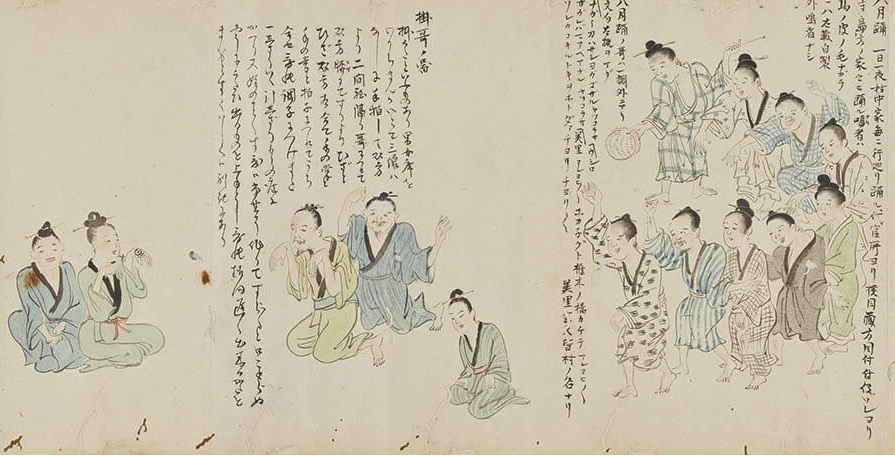
Wonders of the Ryukyu Kingdom, Edo Period (19th century), Collection of Tokyo National Museum
Ryukyu as the "Jinliang of all countries"After the 12th century, the Ryukyu Kingdom entered the Imperial Castle era, which was dominated by farming culture, and formed a cultural zone. At the beginning of the 15th century, King Bazhi unified Ryukyu and was given the surname Shang by the Ming Dynasty in China. He began to build Shuri Castle and conducted frequent commercial exchanges with China, Japan, the Korean Peninsula and Southeast Asia. As a trade transit point connecting all parts of Asia, Ryukyu. The kingdom was at its most powerful at the end of the 15th century, when King Shangzhen was a Buddhist, devoted to developing trade and revitalizing culture. Naha, the port city of the Ryukyu Kingdom, is full of items from various countries, showing the prosperity of Ryukyu as a bridge to Asia.
The exhibition opens with "Wanguo Jinliang" (a bridge connecting many countries in Asia). One of the large bronze bells has an inscription claiming that the Ryukyu Kingdom is the "Wanguo Jinliang" connecting all parts of Asia through ship trade. It is said that this Sanskrit bell once hung in Shuri Castle. main hall.

Bronze bell of the main hall of the old Shuri Castle (Bell of Tenshin Liang of the World), by Zensaku Fujiwara, 1st Shang Dynasty, Tenshun 2nd year (1458), in the collection of the Okinawa Prefectural Museum and Art Museum
Specific to the exhibits, a volume of the ancient ballad "Amaro" circulated in the Ryukyu Islands, its themes involve belief, sacrifice, fortification, shipbuilding, trade, navigation, taxation, island rule and many other aspects.In the exhibition, a pair of three-color pottery water fountains from China are charming. The duck-shaped water fountain shows feather details, and the body is decorated with yellow-green glaze; the crane-shaped water fountain was fired in Fujian at the end of the Ming Dynasty. They were brought to Ryukyu by trade in the 16th century. A large number of crane-shaped water jets were unearthed in Shuri Castle, which shows that the Ryukyu people have a preference for Chinese pottery, and some studies believe that the Shuri court presented them to Noro (women in charge of village sacrifices) in various places.
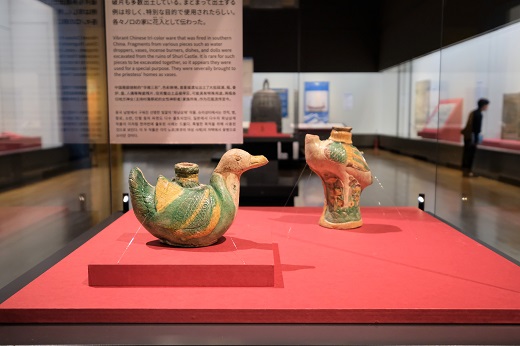
Three-colored duck-shaped and crane-shaped pottery water fountains, Ming Dynasty (16th century)
In the rich natural resources and deep ties with East Asian countries, the Ryukyu people have created a unique history and culture. In particular, women are in charge of rituals, which are related to Okinawa's "Yuri God" (the soul guards married men who are not wives as partners, but sisters). Noro is the woman in charge of the village sacrifices, appointed by the Shuri Royal Palace, to support the rule of the kingdom in terms of religion.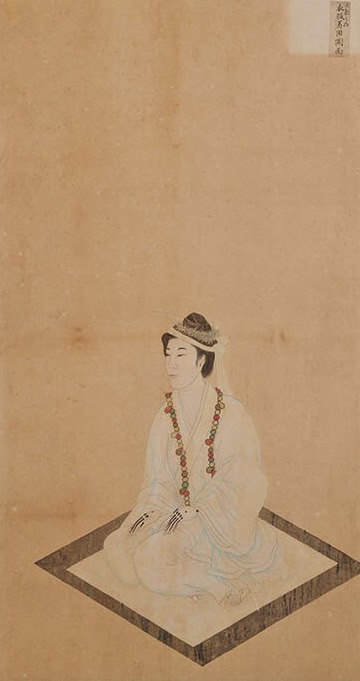
"Noro Tu", Second Shang Dynasty (19th century), Tokyo National Museum
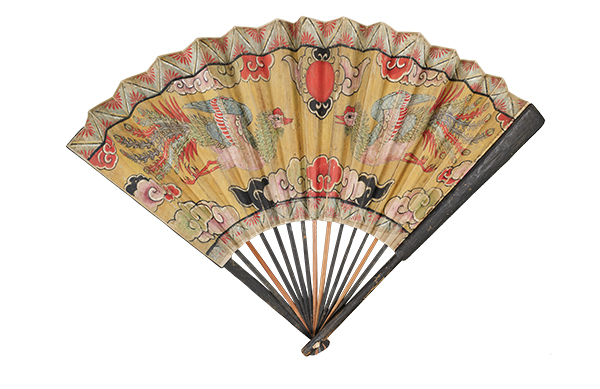
God Fan, Edo Period or Second Shoji Period (19th century), in the collection of Tokyo National Museum;
A large fan used by goddesses who perform sacrifices.
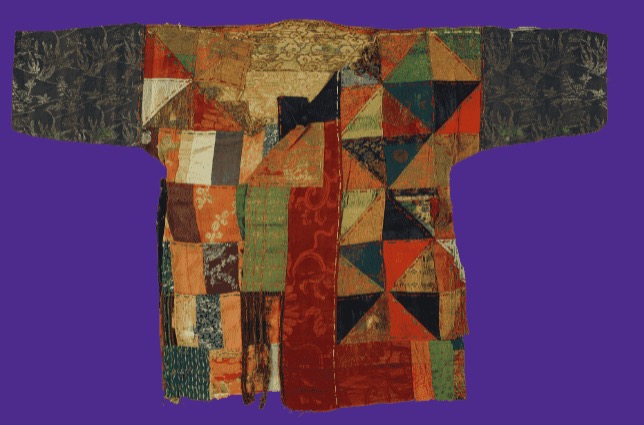
Butterfly robe, Edo period or the second Shangshi period (19th century), in the collection of Tokyo National Museum, butterfly has the meaning of warding off evil spirits in Ryukyu.
Diplomacy and CultureBeginning in 1470, the Ryukyu King Shang Shi ruled Ryukyu for about 400 years. The kings of successive dynasties accepted the canonization of China's Ming and Qing dynasties, and it is a vassal state of China.
According to the history of the Ryukyu Kingdom and various historical records, since the sixteenth year of Hongwu (1383), the Ryukyu kings of all dynasties have requested the canonization of the Chinese emperor to formally determine the relationship between monarch and minister. This relationship lasted for a full five centuries. Even in the 14th year of Keicho, Japan (1609), the Shimadzu clan of the Satsuma clan (now Kagoshima Prefecture) invaded Ryukyu, and the Ryukyu Kingdom was restricted by Satsuma. never changed. In the 25th year of Hongwu (1392), Zhu Yuanzhang "gives thirty-six surnames to Fujian people" to enter the Ryukyu. These Chinese immigrants mainly imparted China's advanced production technology and culture to Ryukyu. The Ryukyu Kingdom also took the initiative to ask for people to be granted. For example, in 1606, when King Shangning was canonized, he asked Ming people to be naturalized. For example, the Cai family who went from China is the descendant of Cai Xiang, and the Lin family is the descendant of the Lin Hejing family. At the same time, the King of Ryukyu often sent his children to study in China.
From the fifth year of Ming Hongwu (1372), the Ryukyu Kingdom has always used the Chinese era name and pursued the Chinese Zhengshuo. (Until the fifth year of Guangxu in the Qing Dynasty (1879), Japan forcibly "abolished Ryukyu County") The official documents, diplomatic treaties, official histories, etc. of the Ryukyu Kingdom were all written in Chinese. Even the palace of its capital, Shuri Castle, does not face south, but faces west, fully expressing its admiration for China. The Ryukyu people also do business with the Japanese, but whenever the Chinese canonized envoys to Ryukyu, the pseudonym, waka, Kuanyong Tongbao (Japanese currency) must be banned, and Tang clothing is changed. Ryukyu also cooperated with China to fight against the Japanese. There is a record in the "History of the Ming Dynasty". For example, in the thirty-sixth year of Jiajing (1557), "First, the Japanese pirates were defeated from Zhejiang and arrived in the Ryukyu territory. The prince Shang Yuan sent troops to invite them to attack them. The six people who were looted in China were returned."
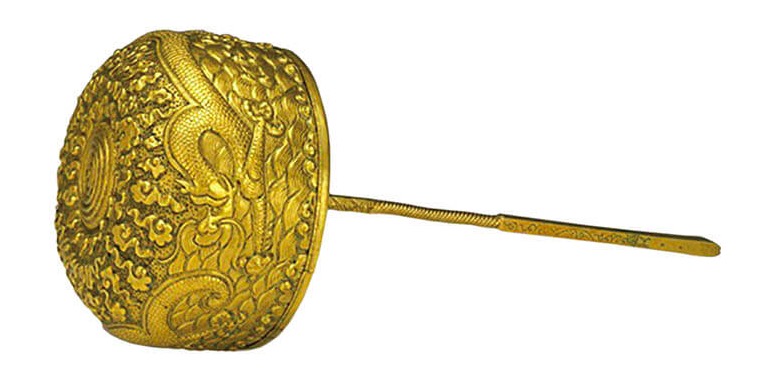
The Yunlong Golden Hairpin of the Imperial Palace, the second Shang Dynasty (15th-16th century), the Okinawa Prefectural Museum and Art Museum The Yunlong Golden Hairpin is said to be the place of the highest-ranking "Master Wende" among the female sacrifices praying for the prosperity of the grain and the peace of the palace. hold. The shape of the hemisphere of the golden hairpin is referred to as the "sun", and it is delicately engraved with water dragon patterns.
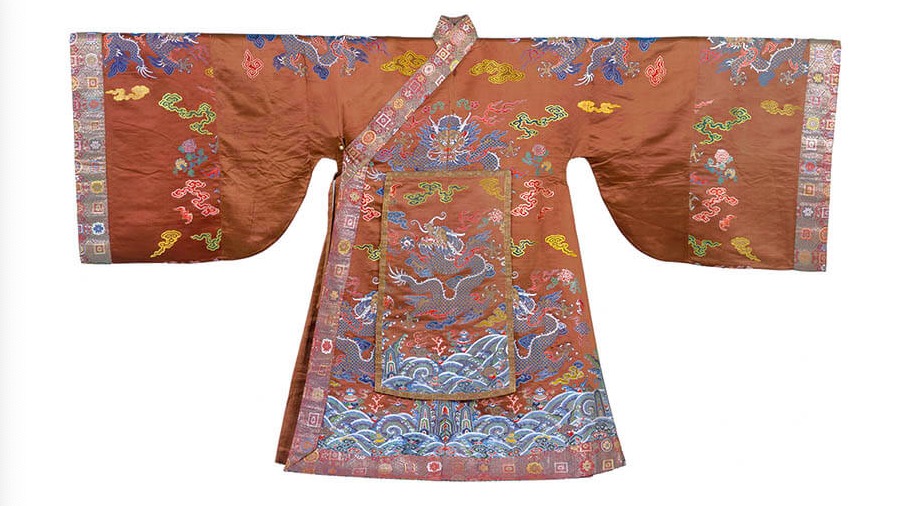
Satin dragon robe with red cloud pattern, the second Shang Dynasty (18th-19th century), Naha City Museum of History, Okinawa, national treasure;
The dress (winter top) worn for important national ceremonies uses the brocade given to Ryukyu by the emperor of the Qing Dynasty. The wide sleeves retain the tradition of dress in the Ming Dynasty, and the drop collar is the style of Ryukyu clothing.

Red Jewel Ruiyun pattern jacket, Second Shang Dynasty (18th-19th century), Naha City Museum of History, Okinawa, National Treasure;
The clothes of the young royal family, the double dragon pattern on it symbolizes the royal family. This jacket uses Ryukyu's unique weaving and dyeing process - "red type", and the pattern is dyed into bright colors through paper molds, which is particularly dazzling in the dazzling southern sunlight.

Yamaguchi Mongji (Wu Shiqian), "Flowers", Second Shang Dynasty (18th century);
Yamaguchi Soki (1672-1743) was a painter in the royal palace, who studied the expression techniques of flower and bird painting in Fujian, China. It is said that his works were introduced to Japan through Satsuma and were well received in Kyoto.
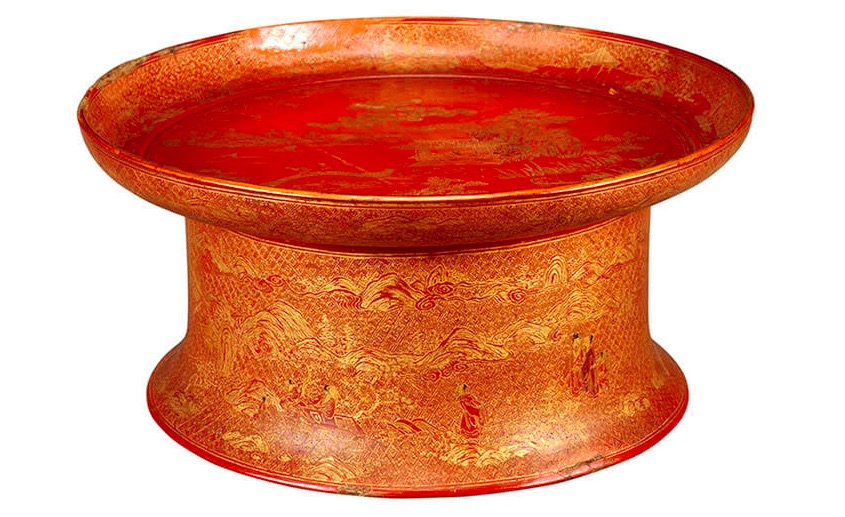
Vermillion Lacquer Landscape Figure with Foot Basin, Second Shang Dynasty (16th-17th Century), Collection of Urasoe City Art Museum, Okinawa;
Ryukyu unique shape with foot basin. The surface of the vessel is made of vermilion lacquer, and the carvings are decorated with the technique of immersion gold folded in gold foil, showing the famous people living in the mountains and forests.
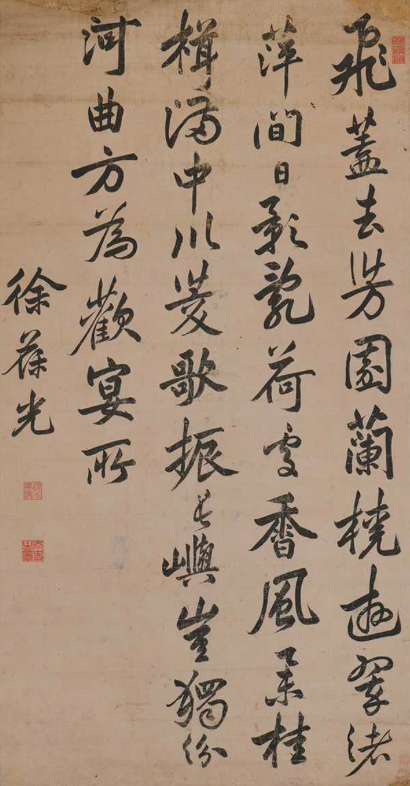
Xu Baoguang, "Five Characters and Rhythm Poems in Cursive Script", Qing Dynasty (18th century), in the collection of Tokyo National Museum;
Xu Baoguang from the Qing Dynasty went to Ryukyu as a canonized ambassador and forged a deep friendship with the local cultural people. This is a scroll of poems written by Ryukyu literati.
In the Ryukyu Islands, known as the South Island, the Ryukyu Islands can be divided into two ages, the Paleolithic Age and the Shell Mound Age, before there are documented records. The shell mound era gave birth to a unique "shell culture" along with coral reefs. People processed shells into practical tools such as axes, or made necklaces, bracelets and other ornaments to wear.
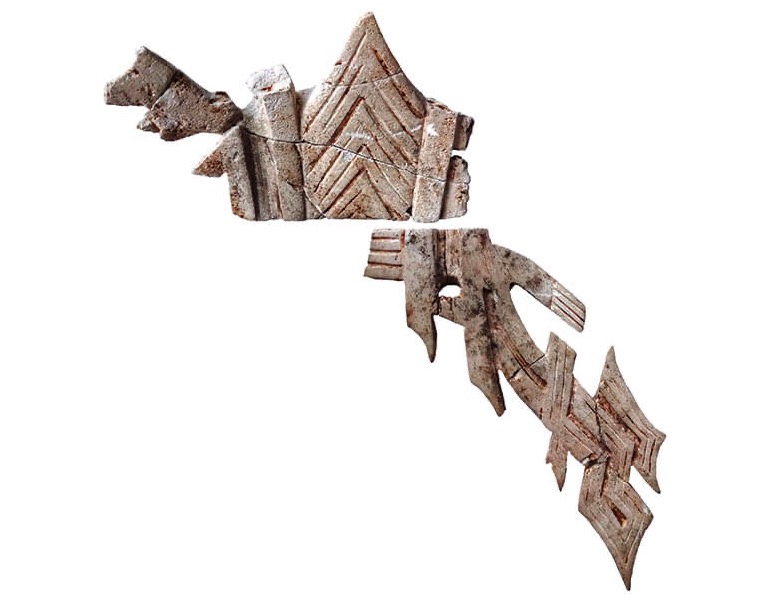
Sphenoid bone products, unearthed from the ruins of the original ruins in Yomitan Village, Okinawa Prefecture in the late Jomon period (1000-400 BC);
Ornaments of the prehistoric culture of Okinawa, made from dugong bones, show the people of the time taking full advantage of the bounty of the ocean.
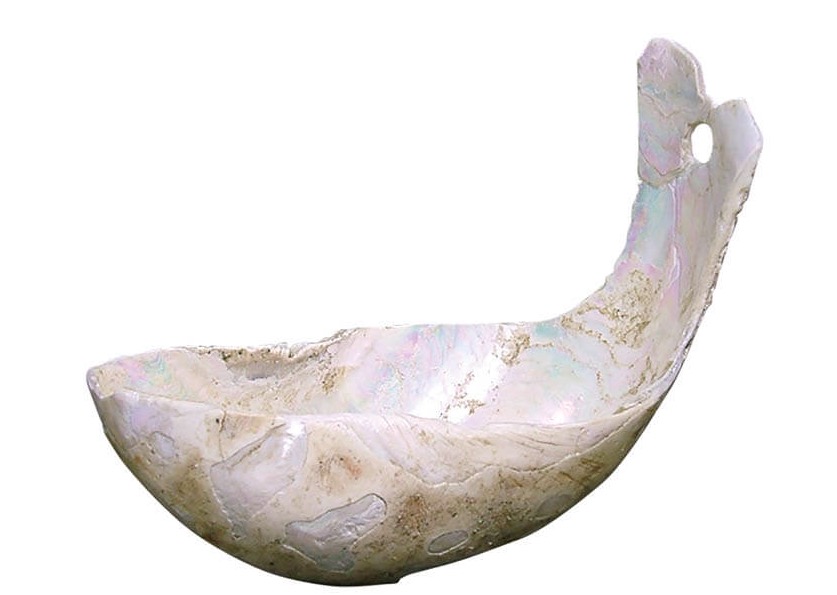
Shell spoon, late shell mound period (6th to 7th century), unearthed from the remains of Kominato Ukidani, Amami City, Kagoshima Prefecture, in the collection of the Amami Museum of Kagoshima Amami City, an important cultural property in Japan;
Making daily necessities and decorations from materials from the sea, such as shells, is a feature of local culture. This work is made by breaking the shell parts, and showing different luster of the nacre according to different grinding degrees.
Since 2015, the Okinawa Prefectural Museum and Art Museum has started the "Ryukyu Kingdom Cultural Heritage Integration and Revitalization" program, dedicated to the restoration of cultural heritage and its production techniques. The currently completed works involve painting, wood carving, stone carving, lacquer art, More than 100 experts and technicians participated in 65 projects in 8 fields including dyeing and weaving, pottery and metalworking. This exhibition introduces Okinawa's "craftsmanship" and how to bring its technology to the future.
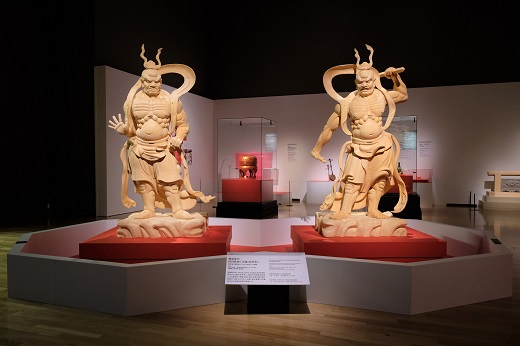
Old Engaku-ji Temple Nio Statue (contemporary replica), Collection of Okinawa Prefectural Museum and Art Museum
The conclusion of the exhibition focuses on the protection of Ryukyu and Okinawa culture. At present, the cultural heritage of a few Ryukyu kingdoms is still under restoration, and it also reminds the world that it is a difficult journey to recover the lost skills and culture.Note: This article is compiled from relevant historical materials and the website of the Tokyo National Museum. The exhibition will last until June 26